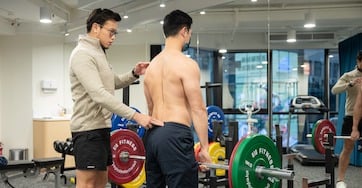Scoliosis is an abnormal curvature of the spine[1]. A normal spine includes a curve at the top of the shoulder and the bottom of the lower back. Your child or teen might have scoliosis if the spine is in an “S” or “C” configuration[2].
What Is Scoliosis?
Scoliosis causes the spine to curve to the left, right or both directions. It can affect people of any age but often starts to show symptoms in children aged 10 to 15[1]. Adolescent girls are more likely to be affected by scoliosis than their male peers[3]. Children and teenagers are also more likely to have scoliosis if anyone in the immediate family has had it before[4].

With early diagnosis, observation, and treatment, most children and teens can have normal and active lives.
What Causes Scoliosis?
The causes of scoliosis are often undetermined. However, in some cases the following conditions might cause it:- Cerebral palsy - A group of disorders that affect a person’s ability to move and maintain balance[5].
- Spinal injuries or infections - Such as spinal cord trauma or bacteria or fungus in the spine.
- Muscular dystrophy - A group of diseases that cause progressive weakness and loss of muscle mass[6].
- Birth defects - That affect the infant’s spinal bones such as spina bifida.
The Most Common Types of Scoliosis
- Idiopathic - The most common form of scoliosis which accounts for 80% of all cases with unknown causes[4].
- Congenital - A sideways curvature that results from embryological malformation of one or more vertebrae[4].
- Neuromuscular - A form of scoliosis that is secondary to neurological or muscular diseases such as cerebral palsy, spinal cord trauma and spina bifida[4].
Scoliosis Symptoms
Scoliosis symptoms can vary depending on the severity of the curves. Most children and teens with mild scoliosis do not have symptoms or pain, making it challenging to diagnose. However, the following signs might be an indication of scoliosis[7]:- Uneven shoulders
- Asymmetric shoulder blades
- Uneven waist
- Pelvic shift
If the scoliosis is more severe, the spinal changes can lead to back pain and might result in complications with the heart and lung functions[6].
How To Get a Scoliosis Diagnosis?
Most children and adolescents do not have symptoms, doctors may diagnose scoliosis during a routine exam such as the school scoliosis screening. The doctor may diagnose scoliosis by[4]:- Looking at medical and family history
- Adam’s forward bend test, a simple initial screening test that can detect potential problems
- Measuring the Cobb Angle, the standard measurement to determine and track the progression of scoliosis[8].
- X-ray, imaging test which uses small amounts of radiation to create a picture of the spine
What Are the Different Scoliosis Treatments?
If your child or teen has scoliosis, your doctor may recommend the following treatments[3]:- Observation - If the curve is mild, the doctor may recommend checking the spine regularly.
- Bracing - If the curve is moderate, the doctor may recommend using a brace to prevent scoliosis progression.
- Scoliosis Surgery - If the curve is severe, the doctor may recommend surgery such as spinal fusion and vertebral body tethering.
- Physiotherapy - The doctor may recommend physiotherapy for pain management and improving muscle strength.
Living With Scoliosis
The outlook for scoliosis depends on the severity of the curvature. For mild to moderate cases, scoliosis will not affect everyday activities. Individuals with severe scoliosis may have physical limitations[2]. The following advice can improve your child or teens quality of life while living with scoliosis[3]:- Regular exercise - Exercise and stretches can help to remain physically fit and improve muscle strength.
- Treatment options - If your child or teen wears a brace, it can affect their body image and self-esteem. Talk to the doctor about other bracing or treatment options.
- Talk to someone - Consider joining a support group or talking to a counsellor. It can help your child or teen with scoliosis and its treatments.
Conclusion
If your child has been diagnosed with scoliosis it does not necessarily mean they have to make drastic lifestyle changes. Even people with prominent spinal curvature can have a good quality of life if it's addressed and their symptoms are controlled effectively. Speak to your healthcare practitioner or visit OT&P’s Orthopaedics Clinic for more information.
References
- National Health Service. (2020). ‘Scoliosis.’ NHS. 3 January 2020. Available from: <https://www.nhs.uk/conditions/scoliosis/> [Accessed 29 September 2021].
- Healthline. (2021). ‘Everything You Need to Know About Scoliosis.’ 5 January 2021. Available from: <https://www.healthline.com/health/scoliosis> [Accessed 29 September 2021].
- National Institutes of Health. (2019). ‘Scoliosis in Children and Teens.’ NIH. December 2019. Available from: <https://www.niams.nih.gov/health-topics/scoliosis#tab-risk> [Accessed 29 September 2021].
- American Academy of Orthopaedic Surgeons. (2020). ‘Introduction to Scoliosis.’ OrthoInfo. April 2020. Available from: <https://orthoinfo.aaos.org/en/diseases--conditions/introduction-to-scoliosis/> [Accessed 29 September 2021].
- Centers for Disease Control and Prevention. (2021). ‘What is Cerebral Palsy?’ CDC. 2 September 2021. Available from: <https://www.cdc.gov/ncbddd/cp/facts.html> [Accessed 29 September 2021].
- Mayo Clinic. (2020). ‘Muscular dystrophy.’ 31 January 2020. Available from: <https://www.mayoclinic.org/diseases-conditions/muscular-dystrophy/symptoms-causes/syc-20375388> [Accessed 29 September 2021].
- Student Health Service. (2021). ‘Bones and Spinal Health.’ Department of Health. January 2021. Available from: <https://www.studenthealth.gov.hk/english/health/health_bsh/health_bsh_sco.html> [Accessed 29 September 2021].
- Radiopaedia. (2021). ‘Cobb angle.’ 18 September 2021. Available from: <https://radiopaedia.org/articles/cobb-angle> [Accessed 29 September 2021].

 Central General Practice
Central General Practice
 Repulse Bay
Repulse Bay
 Clearwater Bay
Clearwater Bay
 BodyWorX Clinic
BodyWorX Clinic
 Central Specialist Clinic
Central Specialist Clinic
 MindWorX Clinic
MindWorX Clinic
 Partner Clinics
Partner Clinics
 Family Clinic
Family Clinic
 OT&P Annerley Midwives Clinic
OT&P Annerley Midwives Clinic

